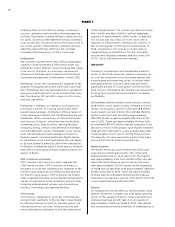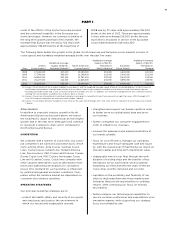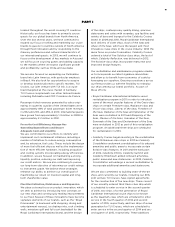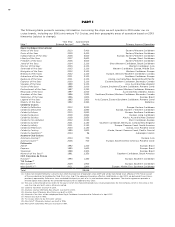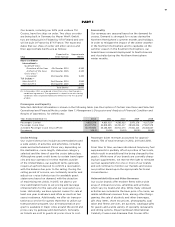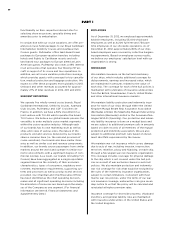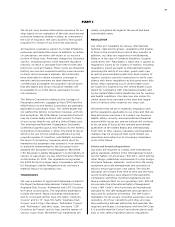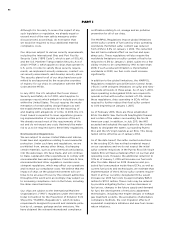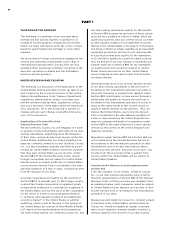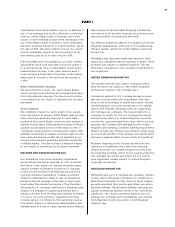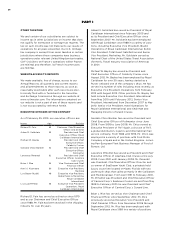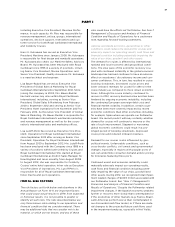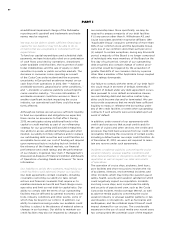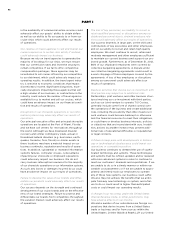Royal Caribbean Cruise Lines 2012 Annual Report Download - page 26
Download and view the complete annual report
Please find page 26 of the 2012 Royal Caribbean Cruise Lines annual report below. You can navigate through the pages in the report by either clicking on the pages listed below, or by using the keyword search tool below to find specific information within the annual report.
22
PART I
Although it is too early to assess the impact of any
such legislation or regulation, we already equal or
exceed most of the new safety measures under
discussion and, accordingly, do not expect that
we would be required to incur additional material
com pliance costs.
Our ships are subject to various security requirements,
including the International Ship and Port Facility
Security Code (“ISPS Code”), which is part of SOLAS,
and the U.S. Maritime Transportation Security Act of
2002 (“MTSA”), which applies to ships that operate in
U.S. ports. In order to satisfy these security require-
ments, we implement security measures, conduct ves-
sel security assessments, and develop security plans.
The security plans for all of our ships have been sub-
mitted to and approved by the respective countries
of registry for our ships in compliance with the ISPS
Code and the MTSA.
In July 2010, the U.S. adopted the Cruise Vessel
Security and Safety Act of 2010, which applies to
passenger vessels which embark or include port stops
within the United States. This act requires the imple-
mentation of certain safety design features as well
the establishment of practices for the reporting of
and dealing with allegations of crime. In 2013, the U.S.
Coast Guard is expected to issue regulations govern-
ing implementation of certain provisions of the act.
We already exceed most of the requirements of the
act and do not expect any costs that would be mate-
rial to us to be required due to these likely regulations.
Environmental Regulations
We are subject to various United States and interna-
tional laws and regulations relating to environmental
protection. Under such laws and regulations, we are
prohibited from, among other things, discharging
certain materials, such as petrochemicals and plastics,
into the waterways. We have made, and will continue
to make, capital and other expenditures to comply with
environmental laws and regulations. From time to time,
environmental and other regulators consider more
stringent regulations, which may affect our operations
and increase our compliance costs. We believe that the
impact of ships on the global environment will con-
tinue to be an area of focus by the relevant authorities
throughout the world and, accordingly, may subject us
to increasing compliance costs in the future, including
the items described below.
Our ships are subject to the International Maritime
Organization’s (“IMO”) regulations under the Interna-
tional Convention for the Prevention of Pollution from
Ships (the “MARPOL Regulations”), which includes
requirements designed to prevent and minimize pollu-
tion by oil, sewage, garbage and air emissions. We
have obtained the relevant international compliance
certificates relating to oil, sewage and air pollution
prevention for all of our ships.
The MARPOL Regulations impose global limitations
on the sulfur content of fuel used by ships operating
worldwide. Permitted sulfur content was reduced
from 4.5% to 3.5% on January 1, 2012. This reduction
has not had a material effect on our fuel and oper-
ating costs. These regulations will also require the
worldwide limitations on sulfur content of fuel to be
reduced to 0.5% by January 1, 2020, subject to a fea-
sibility review to be completed by IMO no later than
2018. If such a reduced limitation is implemented
worldwide in 2020, our fuel costs could increase
significantly.
In addition to the global limitations, the MARPOL
Regulations establish special Emission Control Areas
(“ECAs”) with stringent limitations on sulfur and nitro-
gen oxide emissions in these areas. As of July 1, 2010,
ships operating in designated ECAs are required to
operate on fuel with a sulfur content of 1.0%. Under
these regulations, ships operating in ECAs will be
required to further reduce their fuel sulfur content
to 0.1% beginning on January 1, 2015.
As of February 2013, there are three established
ECAs: the Baltic Sea, the North Sea/English Channel
and certain of the waters surrounding the North
American coast. In addition, in July 2011, the IMO
accepted and adopted the application by the United
States to designate the waters surrounding Puerto
Rico and the US Virgin Islands as an ECA. This desig-
nation will be effective as of January 2014.
As of the date hereof, the sulfur content reductions
in the existing ECAs has not had a material impact
on our operations and we do not expect the initial
sulfur content reductions in the Puerto Rico/US Virgin
Islands ECA will have a material effect on our fuel and
operating costs. However, the additional reduction to
0.1% as of January 1, 2015 will increase our fuel costs
after this date. Based on 2013 itineraries and pro-
jected fuel consumption inside these ECAs, as well as
current fuel prices and technologies, we estimate that
implementation of the 0.1% low sulfur content require-
ment in all four currently designated ECAs would
increase our 2013 fuel costs by approximately $65.0
million to $70.0 million. These costs may be reduced
by possible mitigating factors, such as decreases in
fuel prices, changes in the future supply and demand
for fuel, the development of emissions abatement
technologies, including new engine designs or exhaust
gas treatment systems, the acceptance of alternative
compliance methods, the cost migration effects of
equivalent compliance initiatives and new fuel conser-
vation initiatives.


